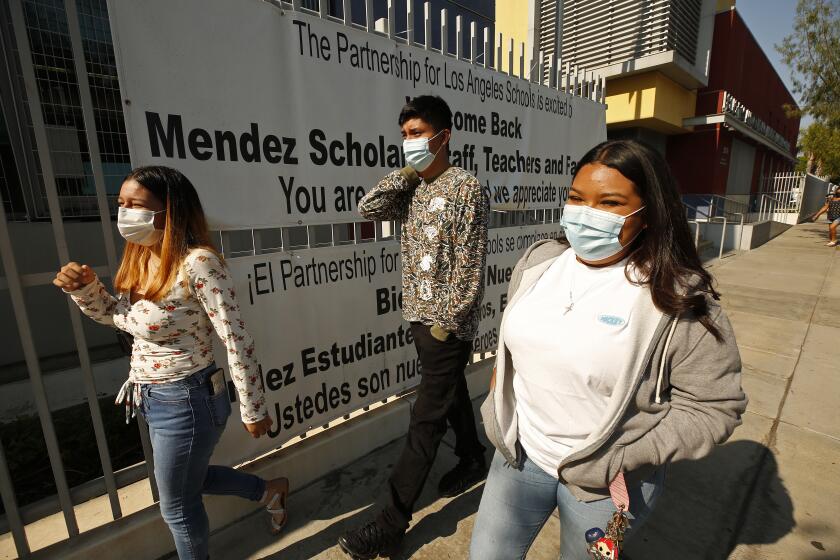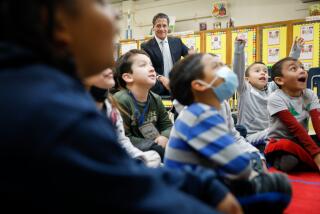L.A. coronavirus outbreaks hit cheerleaders, dance squads

A large number of coronavirus outbreaks involving school-age youths identified in recent weeks in Los Angeles County have involved cheerleading and dance teams.
Between July 30 and Aug. 20, there were nine outbreaks among high school cheerleading and dance teams involving 131 students and 100 staff members.
All were associated with indoor camps outside of Los Angeles County that lasted from two to four days.
“All of these camps gathered student athletes from multiple schools, and schools were asked to enforce their own mask policies for those in attendance,” Los Angeles County Public Health Director Barbara Ferrer said. “But that meant that students that did not have a mask policy in place at their school, they did not wear masks.“
Reportedly, many in attendance didn’t wear a mask during cheer and dance activities, Ferrer said.
“Most of the teams with outbreaks also used school and charter buses for transportation to bring students to the camps each day,” she said, and team members were not uniformly wearing masks.
Eight of the nine outbreaks involved teens who shared hotel rooms with two to six others.
There were no hospitalizations or deaths associated with these outbreaks.
What happens when school children get coronavirus?
“Our findings from these outbreaks suggest that transmission risk is high with close, sustained unmasked contact between people, especially when they’re engaging in physical exertion. And in this case, most of the activities were happening indoors,” Ferrer said.
During the first three days of this week, officials identified five school outbreaks in the county involving 27 students and three staff members, with 135 others exposed. Last week, when many schools, including those in L.A. Unified, reopened for the fall semester, three outbreaks were identified, with 25 students and 60 staff members infected and 79 others exposed.
“We anticipate an upward trend in outbreaks as our schools have reopened, but we’re continuing to work hard to prevent, investigate and manage them as they happen,” Ferrer said.
She called the numbers “sobering” and said Los Angeles County health officials will continue to enforce strict school quarantine rules.
The county quarantine rules, which are stricter than state guidelines, have raised concerns among some school leaders and parents about academic disruption after thousands of students and staff members were sent home in the opening days of the school year. In the Los Angeles Unified School District alone, 6,500 were in quarantine or isolation the first week of class.
“We have a lot of risk right now,” Ferrer said in her weekly media briefing. “The early data we do have on schools is somewhat sobering.”
Some school district leaders in recent days have pressed Los Angeles County to align its quarantine policies with less-stringent state guidelines.
The county requires all “close contacts” of an infected person to quarantine for 10 days after the last exposure unless they are fully vaccinated. Children younger than 12 are not eligible for vaccinations.
The state, however, allows unvaccinated students and staff members who were exposed to remain on campus if both the infected person and the close contact were masked during the exposure.
If the state guidelines were in place, many more students could remain on campus, said Las Virgenes Unified Supt. Dan Stepenosky, who is among those raising the issue. His district of about 10,000 students had 96 students in quarantine Thursday; 92 of them could be in class under the state guidelines, Stepenosky said.
Ferrer said that health analysts are studying data and evaluating whether it is advisable to ease some restrictions. Very few children are becoming seriously ill, although they can spread the infection to others who are at greater risk. Among the issues being examined is what should qualify as a close contact.
“Delta has made it harder for us to get a good sense for what that definition would need to look like,” Ferrer said.
Research that led to past relaxation of school safety measures — and ultimately hastened the reopening of many campuses in the spring — was based on data collected before the rise of the Delta variant, she said.
More to Read
Sign up for Essential California
The most important California stories and recommendations in your inbox every morning.
You may occasionally receive promotional content from the Los Angeles Times.













